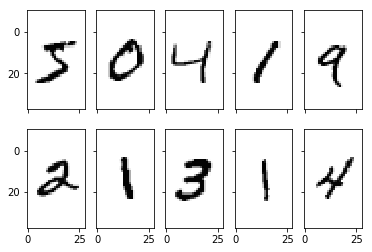MNIST数据集比较小,一般入门机器学习都会采用这个数据集来训练
下载地址:yann.lecun.com/exdb/mnist/
有4个有用的文件:
train-images-idx3-ubyte: training set images
train-labels-idx1-ubyte: training set labels
t10k-images-idx3-ubyte: test set images
t10k-labels-idx1-ubyte: test set labels
The training set contains 60000 examples, and the test set 10000 examples. 数据集存储是用binary file存储的,黑白图片。
下面给出load数据集的代码:
|
1
2
3
4
5
6
7
8
9
10
11
12
13
14
15
16
17
18
19
20
21
22
23
24
25
26
27
28
29
30
31
32
33
34
35
36
37
38
39
40
41
42
43
44
45
46
47
48
49
50
51
52
53
54
55
56
|
import osimport structimport numpy as npimport matplotlib.pyplot as pltdef load_mnist(): ''' Load mnist data http://yann.lecun.com/exdb/mnist/ 60000 training examples 10000 test sets Arguments: kind: 'train' or 'test', string charater input with a default value 'train' Return: xxx_images: n*m array, n is the sample count, m is the feature number which is 28*28 xxx_labels: class labels for each image, (0-9) ''' root_path = '/home/cc/deep_learning/data_sets/mnist' train_labels_path = os.path.join(root_path, 'train-labels.idx1-ubyte') train_images_path = os.path.join(root_path, 'train-images.idx3-ubyte') test_labels_path = os.path.join(root_path, 't10k-labels.idx1-ubyte') test_images_path = os.path.join(root_path, 't10k-images.idx3-ubyte') with open(train_labels_path, 'rb') as lpath: # '>' denotes bigedian # 'I' denotes unsigned char magic, n = struct.unpack('>II', lpath.read(8)) #loaded = np.fromfile(lpath, dtype = np.uint8) train_labels = np.fromfile(lpath, dtype = np.uint8).astype(np.float) with open(train_images_path, 'rb') as ipath: magic, num, rows, cols = struct.unpack('>IIII', ipath.read(16)) loaded = np.fromfile(train_images_path, dtype = np.uint8) # images start from the 16th bytes train_images = loaded[16:].reshape(len(train_labels), 784).astype(np.float) with open(test_labels_path, 'rb') as lpath: # '>' denotes bigedian # 'I' denotes unsigned char magic, n = struct.unpack('>II', lpath.read(8)) #loaded = np.fromfile(lpath, dtype = np.uint8) test_labels = np.fromfile(lpath, dtype = np.uint8).astype(np.float) with open(test_images_path, 'rb') as ipath: magic, num, rows, cols = struct.unpack('>IIII', ipath.read(16)) loaded = np.fromfile(test_images_path, dtype = np.uint8) # images start from the 16th bytes test_images = loaded[16:].reshape(len(test_labels), 784) return train_images, train_labels, test_images, test_labels |
再看看图片集是什么样的:
|
1
2
3
4
5
6
7
8
9
10
11
12
13
14
15
16
17
18
19
20
|
def test_mnist_data(): ''' Just to check the data Argument: none Return: none ''' train_images, train_labels, test_images, test_labels = load_mnist() fig, ax = plt.subplots(nrows = 2, ncols = 5, sharex = True, sharey = True) ax =ax.flatten() for i in range(10): img = train_images[i][:].reshape(28, 28) ax[i].imshow(img, cmap = 'Greys', interpolation = 'nearest') print('corresponding labels = %d' %train_labels[i])if __name__ == '__main__': test_mnist_data() |
跑出的结果如下:

以上就是本文的全部内容,希望对大家的学习有所帮助,也希望大家多多支持服务器之家。
原文链接:https://blog.csdn.net/caichao08/article/details/78988389










